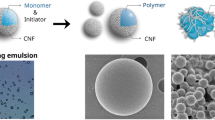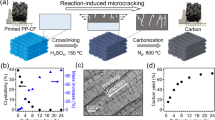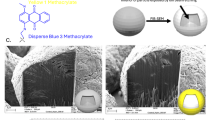Abstract
Non-destructive processing of powders into macroscopic materials with a wealth of structural and functional possibilities has immeasurable scientific significance and application value, yet remains a challenge using conventional processing techniques. Here we developed a universal fibration method, using two-dimensional cellulose as a mediator, to process diverse powdered materials into micro-/nanofibres, which provides structural support to the particles and preserves their own specialties and architectures. It is found that the self-shrinking force drives the two-dimensional cellulose and supported particles to pucker and roll into fibres, a gentle process that prevents agglomeration and structural damage of the powder particles. We demonstrate over 120 fibre samples involving various powder guests, including elements, compounds, organics and hybrids in different morphologies, densities and particle sizes. Customized fibres with an adjustable diameter and guest content can be easily constructed into high-performance macromaterials with various geometries, creating a library of building blocks for different fields of applications. Our fibration strategy provides a universal, powerful and non-destructive pathway bridging primary particles and macroapplications.
This is a preview of subscription content, access via your institution
Access options
Access Nature and 54 other Nature Portfolio journals
Get Nature+, our best-value online-access subscription
$29.99 / 30 days
cancel any time
Subscribe to this journal
Receive 12 print issues and online access
$259.00 per year
only $21.58 per issue
Buy this article
- Purchase on Springer Link
- Instant access to full article PDF
Prices may be subject to local taxes which are calculated during checkout




Similar content being viewed by others
Data availability
The data that support the findings of this study are available from the corresponding authors on reasonable request.
References
Swisher, J. H., Jibril, L., Petrosko, S. H. & Mirkin, C. A. Nanoreactors for particle synthesis. Nat. Rev. Mater. 7, 428–448 (2022).
Xu, L. et al. Enantiomer-dependent immunological response to chiral nanoparticles. Nature 601, 366–373 (2022).
Li, Z., Saruyama, M., Asaka, T., Tatetsu, Y. & Teranishi, T. Determinants of crystal structure transformation of ionic nanocrystals in cation exchange reactions. Science 373, 332–337 (2021).
Gu, D. et al. Material-structure-performance integrated laser-metal additive manufacturing. Science 372, eabg1487 (2021).
MacDonald, E. & Wicker, R. Multiprocess 3D printing for increasing component functionality. Science 353, aaf2093 (2016).
Liu, H. et al. Advanced electrode processing of lithium ion batteries: a review of powder technology in battery fabrication. Particuology 57, 56–71 (2021).
Santos, P. J., Gabrys, P. A., Zornberg, L. Z., Lee, M. S. & Macfarlane, R. J. Macroscopic materials assembled from nanoparticle superlattices. Nature 591, 586–591 (2021).
Wang, C. et al. A general method to synthesize and sinter bulk ceramics in seconds. Science 368, 521–526 (2020).
Kong, D. et al. Influence of nano-silica agglomeration on microstructure and properties of the hardened cement-based materials. Constr. Build. Mater. 37, 707–715 (2012).
Saleh, K., Steinmetz, D. & Hemati, M. Experimental study and modeling of fluidized bed coating and agglomeration. Powder Technol. 130, 116–123 (2003).
Xin, S. et al. Generalizing hydrogel microparticles into a new class of bioinks for extrusion bioprinting. Sci. Adv. 7, eabk3087 (2021).
Hsu, P.-C. et al. Radiative human body cooling by nanoporous polyethylene textile. Science 353, 1019–1023 (2016).
Ma, Z. et al. Permeable superelastic liquid-metal fibre mat enables biocompatible and monolithic stretchable electronics. Nat. Mater. 20, 859–868 (2021).
Yan, W. et al. Single fibre enables acoustic fabrics via nanometre-scale vibrations. Nature 603, 616–623 (2022).
Wang, D. et al. Chemical formation of soft metal electrodes for flexible and wearable electronics. Chem. Soc. Rev. 47, 4611–4641 (2018).
Shi, X. et al. Large-area display textiles integrated with functional systems. Nature 591, 240–245 (2021).
Zhou, Z., Liu, T., Khan, A. U. & Liu, G. Block copolymer–based porous carbon fibers. Sci. Adv. 5, eaau6852 (2019).
Cheng, K. C. et al. Templated nanofiber synthesis via chemical vapor polymerization into liquid crystalline films. Science 362, 804–808 (2018).
Besmann, T. M., Sheldon, B. W., Lowden, R. A. & Stinton, D. P. Vapor-phase fabrication and properties of continuous-filament ceramic composites. Science 253, 1104–1109 (1991).
Bao, Y. X. et al. One-pot synthesis of Pt-Co alloy nanowire assemblies with tunable composition and enhanced electrocatalytic properties. Angew. Chem. Int. Ed. 54, 3797–3801 (2015).
Wu, H. et al. Stable cycling of double-walled silicon nanotube battery anodes through solid–electrolyte interphase control. Nat. Nanotechnol. 7, 310–315 (2012).
Nie, Z., Petukhova, A. & Kumacheva, E. Properties and emerging applications of self-assembled structures made from inorganic nanoparticles. Nat. Nanotechnol. 5, 15–25 (2010).
Xia, Y. et al. One-dimensional nanostructures: synthesis, characterization, and applications. Adv. Mater. 15, 353–389 (2003).
Yan, W. et al. Structured nanoscale metallic glass fibres with extreme aspect ratios. Nat. Nanotechnol. 15, 875–882 (2020).
Shabahang, S. et al. Controlled fragmentation of multimaterial fibres and films via polymer cold-drawing. Nature 534, 529–533 (2016).
Chang, D. et al. Reversible fusion and fission of graphene oxide–based fibers. Science 372, 614–617 (2021).
Doshi, J. & Reneker, D. H. Electrospinning process and applications of electrospun fibers. J. Electrostat. 35, 151–160 (1995).
Kaufman, J. J. et al. Structured spheres generated by an in-fibre fluid instability. Nature 487, 463–467 (2012).
Murphy, C. A. & Collins, M. N. Microcrystalline cellulose reinforced polylactic acid biocomposite filaments for 3D printing. Polym. Compos. 39, 1311–1320 (2018).
Han, Z. et al. Electrospinning of neat graphene nanofibers. Adv. Fiber Mater. 4, 268–279 (2022).
Peterson, G. W., Lee, D. T., Barton, H. F., Epps, T. H. & Parsons, G. N. Fibre-based composites from the integration of metal–organic frameworks and polymers. Nat. Rev. Mater. 6, 605–621 (2021).
Lima, M. D. et al. Biscrolling nanotube sheets and functional guests into yarns. Science 331, 51–55 (2011).
Watts, M. C. et al. Production of phosphorene nanoribbons. Nature 568, 216–220 (2019).
Acknowledgements
This work was financially supported by the National Natural Science Foundation of China (no. U22A20140 to H.L., 21825103 to T.Z., 52072138 to H.L. and 32371508 to Q.S.) and the National Key Research and Development Program of China (no. 2021YFB3800300 to H.L., 2018YFE0206900 to H.L. and 2023YFD2201403 to Q.S.).
Author information
Authors and Affiliations
Contributions
H.L., Q.S., T.Z. and H.W. conceived the idea and supervised all the aspects of the research. G.T. supported the project as an expert. H.W., C.Z. and C.W. fabricated the samples and carried out the measurements. J.F., Y.Y., Y.L. and Z.D. performed the materials characterizations. H.W. and C.Z. evaluated the data and interpreted the results. H.W. and C.Z. wrote the paper, and all authors discussed the results and worked on the paper.
Corresponding authors
Ethics declarations
Competing interests
The authors declare no competing interests.
Peer review
Peer review information
Nature Materials thanks the anonymous reviewers for their contribution to the peer review of this work.
Additional information
Publisher’s note Springer Nature remains neutral with regard to jurisdictional claims in published maps and institutional affiliations.
Extended data
Extended Data Fig. 1 Appearance and basic properties of powder materials.
Optical photograph of powder materials with the true densities (from 1.04 g cm-3 for polystyrene nanospheres to 19.3 g cm-3 for W), tap densities (from 0.1 g cm-3 for Si to 4.5 g cm-3 for Ta) and mean sizes.
Extended Data Fig. 2 Diameters and lengths of GAFs.
a, Diameter distribution of representative GAFs. b, Combined SEM image of ZnO nanosheet GAF spliced from high-resolution SEM images taken along the fibre direction. The magnified SEM images and elemental mappings confirm that the distribution of ZnO in the fibre is uniform.
Extended Data Fig. 3 Schematic mechanism of the fibration process for GAF.
Illustration of the conversion mechanism from powder to GAF based on the deformation process of a 2D-cellulose isomer during water removal. TEM image on the left is 2D-cellulose.
Extended Data Fig. 4 The intermediate state of target GAF during the fibration process.
a, Schematics of in-situ cyro-SEM measurements for this fibration process. b, Cyro-SEM image of the frozen ZnO@2D-cellulose suspension. Arrows indicate that sheet-like ZnO@2D-cellulose intermediates started to shrink and roll up at this solid-gas interface. Dashed lines (b) mark the bifurcated structure in sheet-like guest/cellulose composite intermediates. c-f, Bifurcation characteristic of GAFs containing SiC/CNT (c), diamond (d), ZrC (e), and ten mixed guests (f).
Extended Data Fig. 5 Characterization of a single GAF fibre.
TEM images and schematic diagram of GAF single fibre structure, including different low-content of Nb, Ti, BaTiO3, and W guest. The TEM images show that the 2D-cellulose forms a multi-layer roll-up structure to wrap guest particles within the fibre.
Extended Data Fig. 6 Simulation modeling of the deformation process of 2D-cellulose with guest particles.
Simulation modeling of the deformation process of 2D-cellulose isomer with two ZnO nanoparticles during water removal, when only one side shrunken in the X direction on behalf of the edge part of the nanosheet (OS-Model) (a-d) and two side shrunken in the X direction on behalf of the inside part of nanosheet (TS-Model) (e-h).
Extended Data Fig. 7 The interior structure of a single GAFs.
a, Dual-beam focused ion beam (FIB) analysis of SiO2 (200 nm) GAFs with (b) longitudinal and (c) cross-section SEM images. It shows a uniform distribution of the guest particles which intensely adhere to the 2D-cellulose ultrathin nanosheets within a single GAF. Sheet-like cellulose within GAFs is highlighted by the orange arrows, and their paths formed are also highlighted by the orange lines and circles. Orange lines and arrows highlight the lamellar 2D-cellulose structures in the fibre, which had a very thin cross-section with a section thickness of less than 10 nm. Along the long axis of the fibre in the L-direction, the 2D-cellulose in the profile presents an almost parallel linear structure. In addition, the 2D-cellulose appears as wriggled curves in the cross-sectional SEM images of the fibre in the R-plane, which corresponded to the folding and puckering of the nanosheet.
Extended Data Fig. 8 Diverse macro-architectures built by GAFs.
a-c, Spinnability of GAFs. Optical micrographs of GAFs (a) and GAF-aligned wires (b, c) using Dy2O3 as guest particles. After spinning, the fluffy GAF was compressed into a large fibre with a diameter of several hundred microns. d-f, GAF-based membranes. SEM images of GAF using carbon as guest (d), optical photograph (e), and cross-section SEM image (f) of GAF membranes with different thickness. These SEM images show that the fibres are stable even after ultrasonic and filtration treatments. g, GAF-based blocks. Optical photograph of different shapes of GAFs blocks including cylindrical quinary-GAF block, discoid diamond-GAF block, spherical carbon-GAF, and cuboid-shaped ZrO2/CNT-GAF.
Extended Data Fig. 9 Radar plots comparing the performance of the GAFs, IFs, and OIFs.
Radar plots comparing the properties and synthesis method of the GAFs, inorganic fibres (IFs), and organic-inorganic hybrid fibres (OIFs). The performance for each characteristic is the maximum reported in the literature for their fields, including a comparison of the synthesis methods.
Supplementary information
Supplementary Information
Supplementary Figs. 1–45, Tables 1–8 and discussion.
Rights and permissions
Springer Nature or its licensor (e.g. a society or other partner) holds exclusive rights to this article under a publishing agreement with the author(s) or other rightsholder(s); author self-archiving of the accepted manuscript version of this article is solely governed by the terms of such publishing agreement and applicable law.
About this article
Cite this article
Wang, H., Zeng, C., Wang, C. et al. Fibration of powdery materials. Nat. Mater. (2024). https://doi.org/10.1038/s41563-024-01821-3
Received:
Accepted:
Published:
DOI: https://doi.org/10.1038/s41563-024-01821-3



